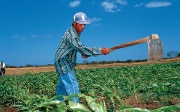The most vulnerable population has access to life saving food
South Sudan continues to experience widespread decline in food production since the end of 2014, which culminated into declaration of famine in 2017 in parts of the country (Unity State), affecting 100,000 people. 1 million people are at the brink of famine and more than two-thirds of the households across the country are facing moderate to severe food insecurity.
The relatively peaceful greenbelt region of the Equatorias, South Sudan’s bread basket, ceased generating a food surplus once the conflict expanded south. The two broad factors that deprive people of food and livelihoods are mainly the man-made conflict, and climate related phenomena, i.e. drought and floods.
On-going insecurity has stopped agricultural activities and displaced populations. The economic decline generated by the conflict has affected trade and resulted into hiked food prices. The integrated food security phase classification (IPC) report established that by January 2017 4.9 million people were severely food and nutrition insecure. This number is projected to rise to 5.5 million, about 47% of South Sudan’s population by the peak of the lean season in July 2017.
- SDC supports WFP and ICRC who are investing extraordinary capacities into airdropping lifesaving food into hard to reach locations of South Sudan, i.e. where road access is impossible and when humanitarian agencies are unable to secure access. WFP has further swiftly responded to the declared famine in South Sudan with SDC’s contribution.
- The South Sudan Food Security and Livelihoods Cluster (FSLC), with support from SDC, is coordinating around 70 partners (national and international NGOs as well as international organisations) in delivering lifesaving food assistance across the country to the neediest.

